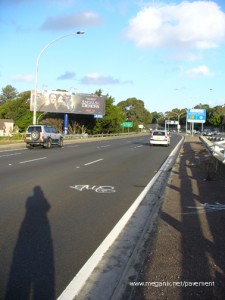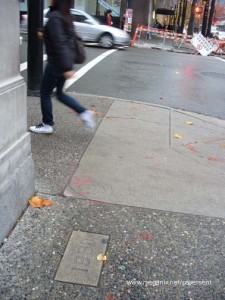 How do I know when the sidewalks of Vancouver were last paved? Easy. The year is impressed into the concrete. Near one of these imprints I found an impromptu wet cement drawing. This piece of pavement graffiti was the first one I photographed after arriving in Vancouver for a conference. It reflected how I felt after the 14-hour flight from Sydney.
How do I know when the sidewalks of Vancouver were last paved? Easy. The year is impressed into the concrete. Near one of these imprints I found an impromptu wet cement drawing. This piece of pavement graffiti was the first one I photographed after arriving in Vancouver for a conference. It reflected how I felt after the 14-hour flight from Sydney.
There is much more that can be read into this small example of the official juxtaposed against the unofficial on the corner of Seymour and West Hastings Streets. Vancouver, readying itself for the 2010 Winter Olympics, is a city I would describe as ‘orderly’, and yet you don’t have to spend too much time in the streets to discover that elements of disorderliness are not entirely suppressed. The Vancouver Olympics Protest Flickr group expose what they see as Vancouver’s problems.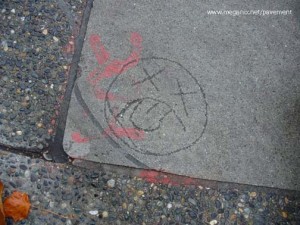
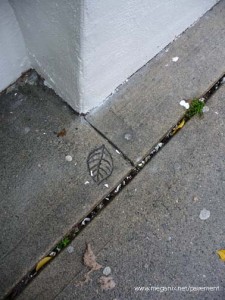 How quaint, I thought. Someone has etched an autumn leaf in wet cement on the sidewalk. Then I noticed another, and then a whole slew of them under an almost bare street tree.
How quaint, I thought. Someone has etched an autumn leaf in wet cement on the sidewalk. Then I noticed another, and then a whole slew of them under an almost bare street tree.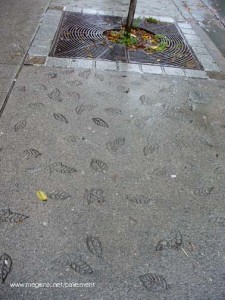 Vancouver has many examples of street art, most of it official, some of it unofficial (though, as you would expect, graffiti mostly occurs at the fringes of Downtown, not in the centre).
Vancouver has many examples of street art, most of it official, some of it unofficial (though, as you would expect, graffiti mostly occurs at the fringes of Downtown, not in the centre).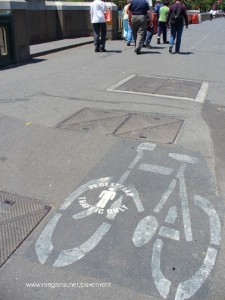 There is an ongoing battle between cyclists and just about everyone else – motorists don’t want them on the roads, pedestrians (like me) don’t want them on the footpaths. The issue is a perennial filler for Sydney newspapers and has flared again this week in news stories, opinion pieces and letters to the editor.
There is an ongoing battle between cyclists and just about everyone else – motorists don’t want them on the roads, pedestrians (like me) don’t want them on the footpaths. The issue is a perennial filler for Sydney newspapers and has flared again this week in news stories, opinion pieces and letters to the editor.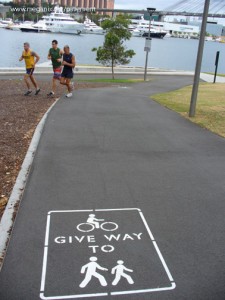 Almost every sign, symbol, graphic and graffiti marked on the roads and sidewalks is a claim for territory. The two examples photographed for today’s blog record instances where pedestrians have had a victory over cyclists, officially at least, and probably only temporarily. The ineptly obliterated bicycle symbol overpainted with a ‘Pedestrian traffic only’ stencil was on the bridge at the corner of St Kilda Road and Flinders Street in Melbourne in 2005. The ‘Give way’ stencils appeared in parks in the City of Sydney towards the end of 2008 after many complaints from pedestrian park-users.
Almost every sign, symbol, graphic and graffiti marked on the roads and sidewalks is a claim for territory. The two examples photographed for today’s blog record instances where pedestrians have had a victory over cyclists, officially at least, and probably only temporarily. The ineptly obliterated bicycle symbol overpainted with a ‘Pedestrian traffic only’ stencil was on the bridge at the corner of St Kilda Road and Flinders Street in Melbourne in 2005. The ‘Give way’ stencils appeared in parks in the City of Sydney towards the end of 2008 after many complaints from pedestrian park-users.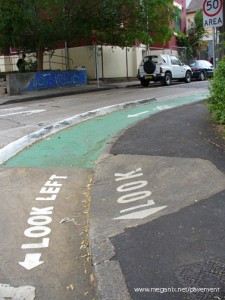

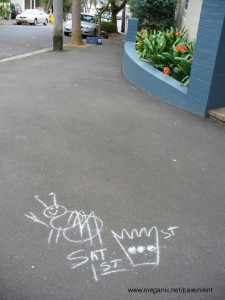 I figured this sign was not meant for me. Some private joke or invitation, but still I was intrigued. Sat 1st? Yes, I got that – the previous Saturday was August 1st. Queen Street? King Street? Crown Street? No streets of that name anywhere near this spot, the corner of Ross and Hereford Streets, Forest Lodge (Glebe). And as for the upbeat insect? Â No idea.
I figured this sign was not meant for me. Some private joke or invitation, but still I was intrigued. Sat 1st? Yes, I got that – the previous Saturday was August 1st. Queen Street? King Street? Crown Street? No streets of that name anywhere near this spot, the corner of Ross and Hereford Streets, Forest Lodge (Glebe). And as for the upbeat insect? Â No idea.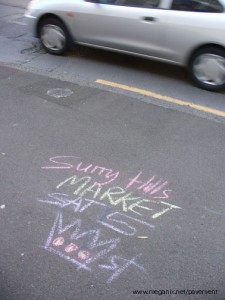
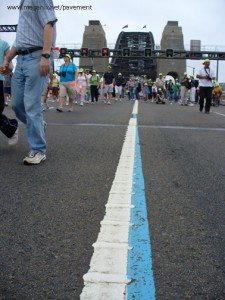 The blue ribbon event of the Sydney 2000 Olympic Games was the marathon, whose 42 km route wound past Sydney’s most recognizable icons and through some of its most telegenic suburbs. A few sections of the blue marathon line have been left in place around Sydney, but only where they do not constitute a traffic hazard.
The blue ribbon event of the Sydney 2000 Olympic Games was the marathon, whose 42 km route wound past Sydney’s most recognizable icons and through some of its most telegenic suburbs. A few sections of the blue marathon line have been left in place around Sydney, but only where they do not constitute a traffic hazard.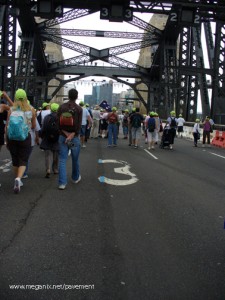
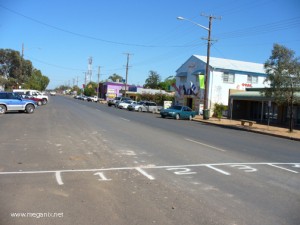 After the crowds have cleared the traces remain. The numbers on the road mark the starting line for the annual Great Goat Race in the main street of Lightning Ridge, NSW. The photograph was taken the day after, on Easter Sunday 2006.
After the crowds have cleared the traces remain. The numbers on the road mark the starting line for the annual Great Goat Race in the main street of Lightning Ridge, NSW. The photograph was taken the day after, on Easter Sunday 2006.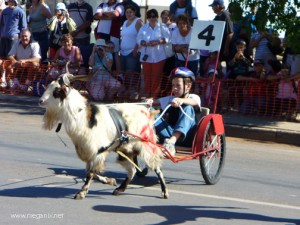
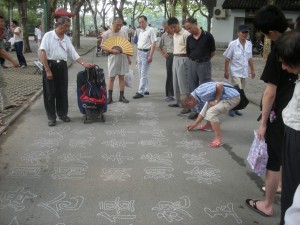 I love Lu Xun Park. It’s in Hongkou, Shanghai, and is my most favourite place on earth at the moment. Everything happens here – there is dance, tai chi, singing, talking, and sitting. Lovely, to me, and I can’t even speak Chinese.
I love Lu Xun Park. It’s in Hongkou, Shanghai, and is my most favourite place on earth at the moment. Everything happens here – there is dance, tai chi, singing, talking, and sitting. Lovely, to me, and I can’t even speak Chinese.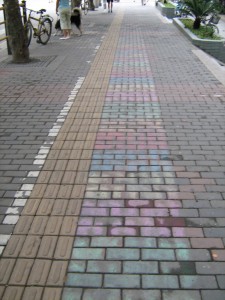 Sometimes migrant workers write their story on the ground asking for help. They come to the city from rural areas and often have trouble finding work. The second photograph was taken after rain had blurred a woman’s story about her current living situation.
Sometimes migrant workers write their story on the ground asking for help. They come to the city from rural areas and often have trouble finding work. The second photograph was taken after rain had blurred a woman’s story about her current living situation.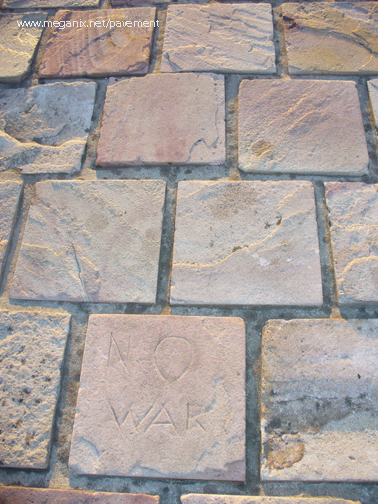 At Federation Square in Melbourne Nearamnew is a public artwork that incorporates the cobblestone paving. According to the
At Federation Square in Melbourne Nearamnew is a public artwork that incorporates the cobblestone paving. According to the 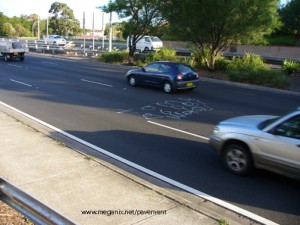 Some people take huge risks to put their tags up (or, in this case, down). And some people also take big risks to get a photo. These two examples are on the Warringah Freeway near Naremburn. It’s late afternoon and most of the traffic is heading north away from the city. But in the mornings the volume of traffic over these tags is enormous. So they have an audience of thousands – if anyone actually notices them. What’s amazing is how long they’ve lasted without being worn away. The photograph was taken in May and they are still there three months later.
Some people take huge risks to put their tags up (or, in this case, down). And some people also take big risks to get a photo. These two examples are on the Warringah Freeway near Naremburn. It’s late afternoon and most of the traffic is heading north away from the city. But in the mornings the volume of traffic over these tags is enormous. So they have an audience of thousands – if anyone actually notices them. What’s amazing is how long they’ve lasted without being worn away. The photograph was taken in May and they are still there three months later.